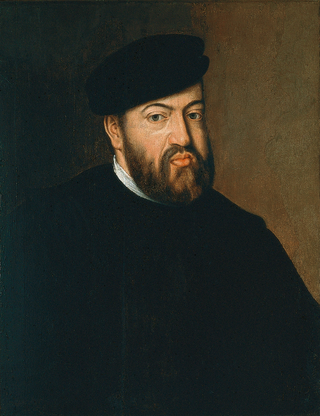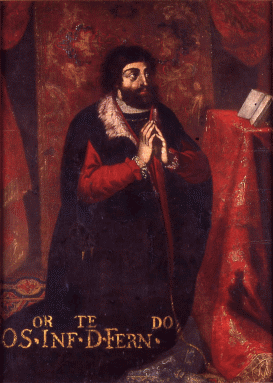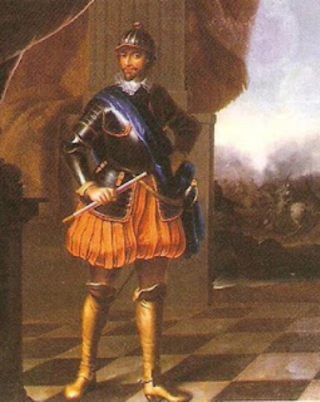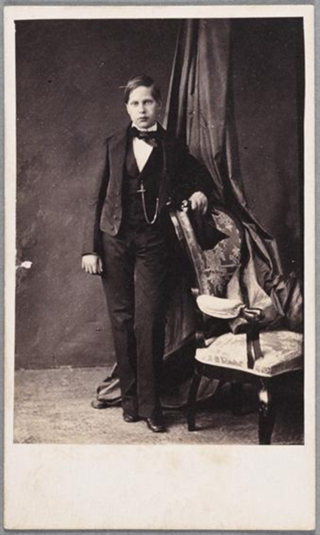
Manuel I, known as the Fortunate, was King of Portugal from 1495 to 1521. A member of the House of Aviz, Manuel was Duke of Beja and Viseu prior to succeeding his cousin, John II of Portugal, as monarch. Manuel ruled over a period of intensive expansion of the Portuguese Empire owing to the numerous Portuguese discoveries made during his reign. His sponsorship of Vasco da Gama led to the Portuguese discovery of the sea route to India in 1498, resulting in the creation of the Portuguese India Armadas, which guaranteed Portugal's monopoly on the spice trade. Manuel began the Portuguese colonization of the Americas and Portuguese India, and oversaw the establishment of a vast trade empire across Africa and Asia.

John III, nicknamed The Pious, was the King of Portugal and the Algarves from 1521 until his death in 1557. He was the son of King Manuel I and Maria of Aragon, the third daughter of King Ferdinand II of Aragon and Queen Isabella I of Castile. John succeeded his father in 1521 at the age of nineteen.

John II, called the Perfect Prince, was King of Portugal from 1481 until his death in 1495, and also for a brief time in 1477. He is known for re-establishing the power of the Portuguese monarchy, reinvigorating the Portuguese economy, and renewing his country's exploration of Africa and Asia.

The Most Serene House of Braganza, also known as the Brigantine dynasty, is a dynasty of emperors, kings, princes, and dukes of Portuguese origin which reigned in Europe and the Americas.

Eleanor of Viseu was a Portuguese infanta (princess) and later queen consort of Portugal. She is considered one of her country's most notable queens consort and one of the only two who were not foreigners. To distinguish her from other infantas of the same name, she is commonly known as Eleanor of Viseu or Eleanor of Lancaster. In Portugal, she is known universally as Rainha Dona Leonor.
João is the Portuguese equivalent of the given name John. The diminutive is Joãozinho and the feminine is Joana. It is widespread in Portuguese-speaking countries. Notable people with the name are enumerated in the sections below.

Infante Ferdinand, Duke of Viseu and Beja was the third son of Edward, King of Portugal and his wife Eleanor of Aragon.

Duarte, Duke of Guimarães was a Portuguese infante (prince); the sixth son of King Manuel I of Portugal and his wife Maria of Aragon.

Eleanor of Aragon was Queen of Portugal from 1433 to 1438 as the spouse of King Edward. After Edward's death, she served as regent in 1438-1440 for her son Afonso V. She was the daughter of Ferdinand I of Aragon and Eleanor of Alburquerque.

Dom Fernando II of Braganza was the 3rd Duke of Braganza and the 1st Duke of Guimarães, among other titles. He is known for being executed for treason against the King.
Constable of Portugal was an office created by King Ferdinand I of Portugal in 1382, to substitute the High Standard-bearer (Alferes-Mor) as the head of the Portuguese Military. It was also referred as the Constable of the Kingdom.
João Esteves da Veiga de Nápoles (1397–1461) was a Portuguese nobleman and Minister-Counselor, the eldest son of Leonardo Esteves de Nápoles and his wife Margarida Anes Afonso. He was the 1st Lord (Senhor) of Salvaterra de Magos, Montargil, Vacariça and Vila Nova de Monsarros.

Duke of Beja was an aristocratic Portuguese title and royal dukedom, associated with the Portuguese Royal House.

Infante Diogo of Viseu (1450–1484) was the second son of Ferdinand, Duke of Viseu, and his wife Beatriz, Duchess of Viseu.

Infante Fernando of Portugal was the fourth son of Queen Maria II of Portugal and King-consort Fernando II and a member of the House of Braganza.

São João Baptista, nicknamed Botafogo ("Spitfire"), was a Portuguese galleon built in the 16th century, around 1530, considered one of the biggest and most powerful Portuguese warships.

The Portuguese conquest of Goa occurred when the governor Afonso de Albuquerque captured the city in 1510 from the Adil Shahis. Old Goa became the capital of Portuguese India, which included territories such as Fort Manuel of Cochin, Bom Bahia, Damaon, and Chaul. It was not among the places Albuquerque was supposed to conquer. He did so after he was offered the support and guidance of Timoji and his troops.
The Prior of Crato, was the traditional title given to the head of the Order of the Knights of St. John of Jerusalem (Hospitaller) in Portugal. It is a reference to the domains of the order around Crato, Portugal.
Portugal S.A. is a 2004 Portuguese drama film directed by Ruy Guerra. It was entered into the 26th Moscow International Film Festival.
Justa Rodrigues, also known as Justa Rodrigues Pereira, was a Portuguese noblewoman and member of the royal household who became a Franciscan nun of the Order of Saint Clare later on in life and founded the Convent of Jesus in Setúbal, Portugal.















